Berlin, Germany, August 7th - 13th, 1910
The summer national meeting at Johannisthal

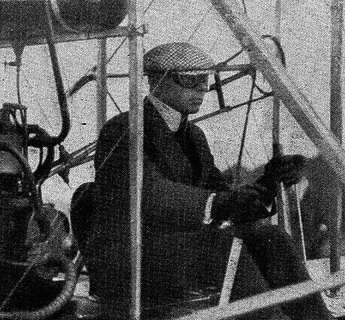

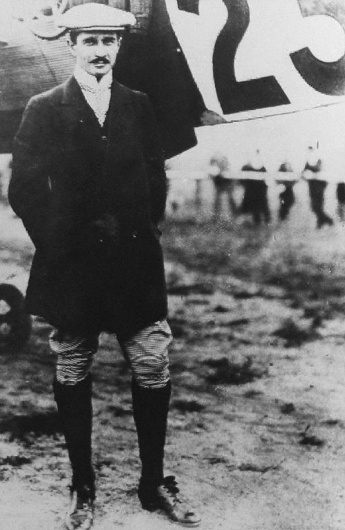

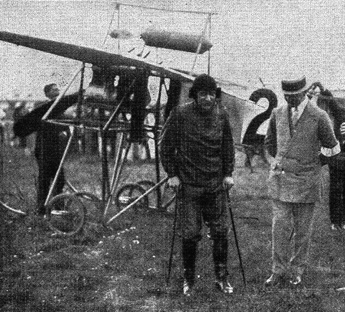
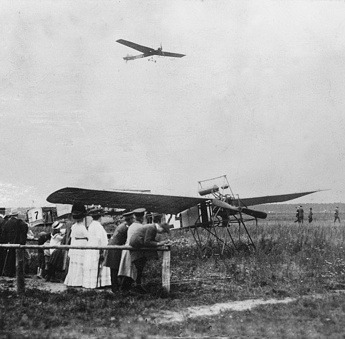
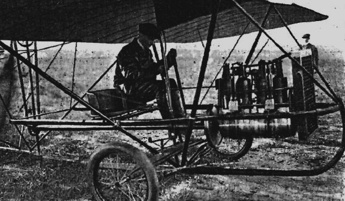
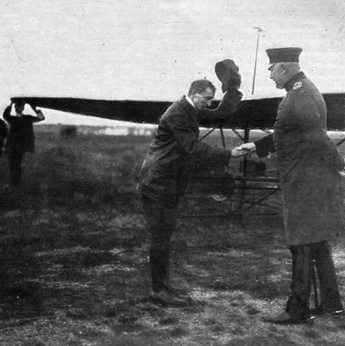

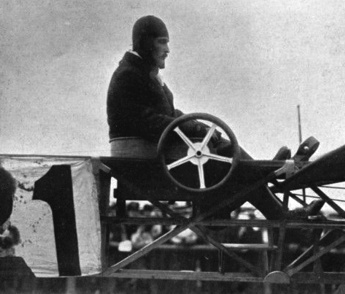
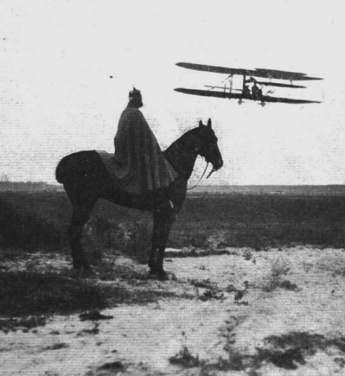


The second of the three 1910 meetings at the
Johannisthal airfield was a national meeting, restricted
to German pilots. The "Flug- und
Sportplatz-Gesellschaft Berlin-Johannisthal" had
further improved the facilities of the airfield. More
hangars were constantly added, the ground surfaces had
been improved and a horse-drawn tramline was built, with
a stop north of the airfield. Flying would still take
place around the 1909 2.5-kilometre course, since the
planned extension of the field had still not been
finished.
21 German pilots were licensed at the time, and 15 of
them entered a total of 26 machines. 24 of them were
scrutinized and approved by the officials the day before
the meeting. The program didn't include any of the
novelties that were introduced at the spring
international meeting, but included contests for
altitude, flying time, highest load and shortest take-off
run. Official timed flights could take place between five
o'clock and eight o'clock.
The participants could also make efforts for two of the
standing prizes for German pilots. The original three
Lanz Prizes, donated by industrialist Karl Lanz for the
first three flights of two kilometres with turns in
different direction at each end, by a German pilot in an
airplane designed and built in Germany and equipped with
a German engine, had already been won by Hans Grade,
Adolf Behrend and Hermann Dorner, but the Kaiserliche
Automobil-Club and the Berliner Verein für Luftschiffahrt
had put up three additional prizes, of 2,000, 1,500 and
1,000 Mark respectively. The Bleichröderpreis of 10,000
Mark was donated by banker James von Bleichröder, and was
supplemented by a second prize of 1,000 Mark, donated by
the Kaiserlichen Automobil-Club. It would be given to the
pilot who completed three laps of the Johannisthal course
during one of the three 1910 meetings in the shortest
time. Between each lap the pilot was required to land
between the last pylon and the start/finish line and
remain stationary for at least one minute with the engine
running.
Sunday 7 August
The weather had been rather bad the last days before the
meeting. When the meeting started it was brighter, but a
strong wind, with gusts up to 16-18 m/s, was blowing from
the west. This didn't discourage the visitors and the
spectator areas were quite crowded, but the planes could
not even be brought out of their hangars. The wind
didn't decrease until around five o'clock, but
then it started raining, and when the rain stopped, the
wind increased again.
Most of the spectators had to leave disappointed, and the
few patiently remaining didn't get to see any flying
until almost eight o'clock - but it wasn't an
aeroplane. It was Käte Paulus in her balloon
"Carola". She had lifted off from the Luna-Park
at Halensee, some 17 kilometres north-west of the
airfield, and passed above the airfield at great speed.
Soon afterwards the cannon shot announced the end of the
day's flying.
Monday 8 August
It was still windy on the second day. The average wind
speed was 6-7 m/s and it was quite gusty, so it took a
long time before the first pilot ventured out of the
hangars. It was Paul Engelhard, who took off at 17:13
from the Wright hangars on the opposite side of the field
from the "Startplatz", the main hangar area
with the main grandstands. His first flight lasted only
two minutes, and he had to work hard at the controls.
Around an hour later he made a second flight, but again
gave up fighting the wind and landed after four minutes.
After Engelhard's flights there was no action for an
hour. Robert Thelen's Wright was made ready, but
didn't move. There was a different kind of flying on
the airfield though: A bird's nest was found in the
grass in front of the hangars! A couple of larks had
managed to raise four or five chicks, despite the
disturbances of the last weeks. They were now almost
ready to take flight, and their parents fluttered
nervously above. The area around the nest was quickly
fenced in, so that nobody would step in it by accident.
At half past six Eugen Wiencziers rolled out one of his
three Antoinettes for a passenger flight, but the engine
didn't run well, so he returned to switch to another
machine. Meanwhile, Thelen and Engelhard started
passenger flights, but neither flew more than a few laps.
At 19:37 Wiencziers took off in his second machine, with
his mechanic as passenger. He worked hard in the gusty
wind to reach the twenty minutes required for the daily
endurance prize. The wind decreased a little towards the
end of the flight, and he flew on for 31 minutes, since
for some reason the eight o'clock cannon shot
wasn't fired. This flight won him the first daily
endurance prize, together with a 300 Mark bonus for
winning it with a passenger on board. After landing, he
claimed that he would never again risk an expensive
airplane in such windy conditions.
Tuesday 9 August
Windy conditions continued to haunt the meeting, with
wind speeds reaching 10-12 m/s during the afternoon.
Nobody tried to fly until around six o'clock, when
Engelhard took off. He had only covered half a lap when
his engine stopped, forcing him to land in front of the
"Startplatz". After a while he managed to get
his engine started and headed back towards his hangar,
flying very low. Suddenly the right front wheel got
caught in the vegetation, the plane was turned around and
hit the ground. Engelhard got away unharmed, but a
landing skid was broken and the machine had to be pulled
back to its hangar by horses. Fridolin Keidel took off
immediately after seven o'clock. He flew very low too
and, like his fellow Wright pilot, got stuck in the grass
after half a lap, but apparently without causing any
damage.
Immediately afterwards Adolf Behrend took off in his
Schultze-Herfort monoplane and made a test flight of
eight and a half minutes, before giving up because of the
pain of a foot that he had injured in an accident before
the meeting. Wiencziers took off at 19:12, again with his
mechanic on board. After a long ground run he climbed to
a height of 25 to 30 metres, constantly adjusting the
elevators to compensate for the gusts that pitched the
big machine up and down. Simon Brunnhuber took off in his
Sommer at 19:18, soon followed by Keidel, who brought a
passenger, and at 19:22 by Thelen. Four minutes later
Oskar Heim took off for the first time with his Wright.
After a few laps, Thelen climbed to 80 to 100 metres, an
altitude that Heim also reached quickly. Then Felix
Laitsch took off in his Voisin, making it six planes were
in the air at the same time, a quite impressive sight.
Wright pilots Thelen and Heim flew slowly high up,
Wiencziers flew a little lower, but visibly faster, while
Brunnhuber and Keidel, who landed again after five
minutes, flew close to the ground. Then Hermann Dorner
took off in his monoplane, followed at 19:45 by Emil
Jeannin in his new Aviatik biplane, who landed after ten
minutes.
When the cannon shot announced the end of the day's
flights there were still five machines in the air. Thelen
had spent almost forty minutes in the air, beating
Wiencziers by almost two minutes. Third and fourth places
were claimed by Heim and Dorner, who had both flown
between 26 and 27 minutes.
Wednesday 10 August
The weather finally turned better, with light winds that
turned into almost complete calm towards the evening. Big
crowds gathered at the airfield and several pilots flew
during the afternoon, but the proceedings were
interrupted by a dramatic accident shortly after seven
o'clock. At 18:45 Oskar Heim tried to take off with a
passenger, but failed to get off the ground. He turned
back to the hangars and made a new effort, this time
without the passenger. He quickly climbed to 112 metres
and had circled the airfield at slightly lower altitude
for 17 minutes when a rigging wire came loose and fouled
the left propeller. The propeller broke apart, and parts
of it hit the horizontal tail stabilizer of his Wright
and ripped it off. The machine immediately pitched down
and rolled to the left. It tumbled to the ground and hit
the earth sideways, on the back straight opposite the
Startplatz. Spectators screamed in horror and cars and
ambulances speeded towards the accident site. Heim was
found among the tangled rigging wires of the wreckage,
with the fuel tank resting on top of his body. He was
unconscious, but he had fortunately fallen on relatively
soft ground and had not been hit by the heavy engine. He
was driven, still unconscious, to the nearby district
hospital in Britz, where the doctors stated that his
injuries were serious, but not life-threatening. Nothing
was broken, but he had suffered a bad concussion, was
severely bruised, and his thigh had been pierced by a
metal part from the broken airplane.
Since there was no risk to Heim's life the officials
decided that the flying could continue, but most of the
pilots who were in the air landed anyway, one after the
other. Only Jeannin kept flying, and Wiencziers and
Dorner joined him during the last half hour.
Jeannin's total flying time of the day was 1 hour 49
minutes, beating Brunnhuber, who was second with 1 hour
11 minutes. The longest non-stop flight, 45 minutes, was
made by Wiencziers. Jeannin took the lead in the take-off
contest with a distance of 70.8 metres. Laitsch completed
the test for the Bleichröderpreis with ease, in 10:19.2.
Ellery von Gorrissen, who stated that it was boring to
fly circles around a marked course, had made three long
flights outside the airfield between five and seven
o'clock. This was forbidden by the rules of the
meeting, so it was speculated that he would be
disqualified.
Thursday 11 August
The good weather and the successful flights on the
previous day attracted large crowds to the airfield on
the fifth day. Most of the pilots had entered for the
shortest take-off contest, in which Jeannin had taken the
lead the day before. Thelen improved this to 47.3 metres
and then managed to repeat the performance, exactly to
the centimetre. Brunnhuber, Laitsch, Dorner, Jeannin and
Theodor Schauenburg made several efforts, but nobody
managed to beat Thelen's result. Dorner then tried
for the Bleichröderpreis, claiming the lead with a flight
of 10:08.6.
After these efforts Kriegsminister Josias von Heeringen
arrived, together with a big entourage. This signalled
the start of the flights for the special prizes offered
by the War Ministry. These contests for load-carrying and
altitude were restricted to pilots who had not yet won
more than 5,000 marks. The load carrying contest was
first. The rules required the pilots to carry at least
140 kilograms, including the pilot, for at least five
minutes. The first one in the air, at seven o'clock,
was Dorner, whose total load, including several carefully
weighed sandbags, was 182.9 kg. He made a flight of 7:45,
of which 6:29 was officially credited. His lead
didn't last long, since Thelen almost immediately
improved the mark to 190 kg during a flight of 7:25. At
half past seven Thelen extended his lead by carrying 210
kg for seven minutes. Immediately after having the weight
checked, he took off for the altitude contest. Thelen
reached an initially reported altitude of 277 metres
after climbing constantly over a five-lap flight, but the
result was later confirmed, with incredible precision, as
298.76 metres.
Soon after seven o'clock Jeannin took off for the
daily endurance prize, which he secured by safely
circling the course until the eight o'clock deadline,
using his smaller #13 spare machine since the other had a
radiator problem.
Von Gorrissen, who had indeed been disqualified from the
contests, took off at 19:12 and again left the airfield
after flying one lap. He steered westward and didn't
return until eight o'clock. He had flown to the
hospital in Britz, intending to visit Heim, but
Heim's was still reported to be unconscious. Since
Heim's condition didn't allow any visits
Gorrissen could only leave a business card.
Wiencziers took off at 19:42 with his mechanic König as
passenger. He landed after 19 minutes, but flared too
late and touched down heavily. The machine bounced and
when it hit the ground a second time the fuselage buckled
at the landing gear. One of the wings was also damaged,
so that machine was out of action for the rest of the
meeting.
The Wright team was reported to have filed a protest
against Jeannin's endurance prize winning flight of
the day before, since they claimed that their pilots
hadn't been allowed to fly after Heim's accident.
Jeannin was listed as winner in the final official
results, so the protest must have been disregarded.
Friday 12 August
The day started with some short tests by Wiencziers,
Engelhard and Jeannin, but then there was a long break.
The reason was that the pilots had gone on strike! The
reason was a controversy over the coloured armlets that
pilots, crew members and different officials had to wear.
The rules prescribed that pilots and crew members had to
wear blue armlets. Wiencziers didn't want to wear the
same armlet as his mechanics, and on the day before he
was denied access to his damaged machine because he
refused to wear the armlet. He and his crew, who also
didn't wear any armlets, were driven off by
horse-mounted policemen, immediately in front of the
crowds. After this embarrassing intermezzo the organizing
committee had a quick meeting and informed the pilots, in
writing, that they had wear their armlets. Wiencziers
refused to receive his letter, thereby adding fuel to the
fire. He was supported by Thelen, with the consequence
that they were both given a fine of 25 Marks and
threatened with further sanctions. Other pilots, among
them Grade and Plochmann. supported their fellow pilots,
and long negotiations followed. In the end, around half
past seven, the disagreements were settled. Wiencziers
and Thelen gave up their opposition and the fines were
withdrawn, so flying could finally begin.
Jeannin won the daily endurance prize with a flight of
31:40, beating Engelhard's 22:13. Engelhard also won
the passenger prize, and in second flight carried a load
of 211 kg for 6:05 to take the lead in the load-carrying
prize. Grade and Plochmann finally pulled their machines
out of the hangars and made a couple of short flights.
Weincziers also found time to make a couple of short
tests in his Gnôme-powered Antoinette. Dorner's
machine had engine and propeller problems and was out of
action for the rest of the meeting.
Saturday 13 August
The meeting finished as it had started, with grounded
airplanes. The wind speed was 8 to 9 m/s, and even more
in the gusts during the thunderstorms, so flights were
impossible. Jeannin disassembled his machine already
during the afternoon, in order to go to Frankfurt for the
Frankfurt-Mannheim cross-country race the next weekend.
There was more controversy in the meeting rooms of the
committee. Engelhard's first place in the
load-carrying contest was protested on the grounds that
his winning margin was so small, only 1 kg, and that his
load was weighed at the Wright hangars on the opposite
side of the airfield and not with the same scales at the
Startplatz that were used by the other contestants.
Engelhard offered to repeat the flight with the load
weighed with the official scales. He managed to briefly
get off the ground, but was forced to land after only 25
seconds because of the winds. The committee decided to
deduct four kilograms from his result, which gave the win
to Thelen, but both Engelhard and third place holder
Dorner announced that they would protest the decision.
The only other action on the airfield was when Wiencziers
took out his machine and entered for the altitude prize
some minutes before the official flying time closed. He
actually never intended to fly, and only made a ground
run and then abandoned the take-off. His reason for doing
this was to ensure that Thelen would get the altitude
prize money. He would not have been entitled to the prize
if there hadn't been a second contestant, and
Wiencziers' effort ensured that the formalities were
fulfilled. Jeannin had flown for 2 h 41:40 and won the
prize for the longest total flying time, beating
Wiencziers by only three minutes.
Conclusion
Although the German aviation press stated that German
pilots had nothing to be ashamed of in comparison to
those of other countries, it was obvious that no
significant performances had been achieved. This was of
course to a large extent to be blamed on the weather. Two
days had been completely wasted, and most of the flying
had taken place on only three days.
With exception for Heim's accident there had been no
major accidents. Oskar Heim eventually recovered from his
injuries, but he would never pilot an airplane again. The
Kriegsministerium awarded him a special prize of 1,500
Mark, part of the unclaimed prize money from other
contests.
According to "L'Auto", the
Kriegsministerium on the day after the meeting announced
a prize for dropping a five-kilogram weight from an
altitude of 50 metres on a five by three metre
rectangular target. None of the pilots present entered,
since they didn't think it was safe. It was reported
that Brunnhuber flew for 63 minutes and Laitsch for 59
minutes.
 Back to the top of the page
Back to the top of the page
